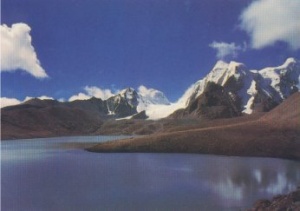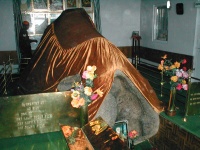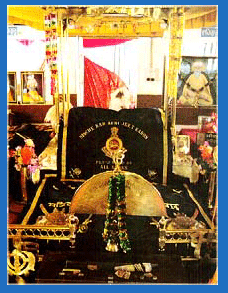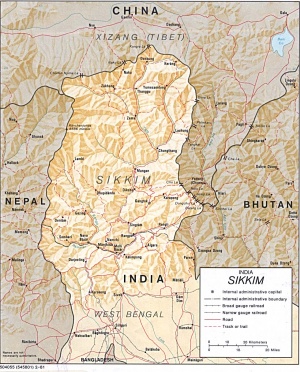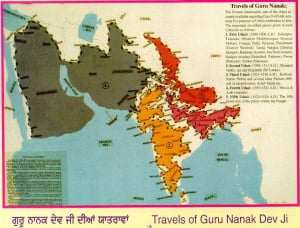Nanak in Sikkim, Ladakh and Tibet
Introduction
In his lifetime Guru Nanak traveled to distant places and one such place was Tibet. Guru Nanak is well respected by Tibetan Buddhists who consider him a saint; The Dalai Lama, spiritual leader of Buddhists in Tibet, has confirmed it in his discussions with some Sikh leaders and that Tibetans revere Guru Nanak as a Buddhist saint under the name of Guru Gompka Maharaj.
According to the local legends of North Sikkim, some people approached Guru Ji with an appeal for help. The lake had remained frozen during most of the year and rendered it incapable as a source of water. Guru Nanak Dev Ji is said to have touched the lake with his foot, and it has never frozen since. Guru Nanak's footprints, a robe and a water-carrying utensil are preserved in a nearby place called Lachen Gompha. Here the locals refer to Guru Ji as Rimpoche Nanak Guru who on his way to Tibet had rested there.
Some grazers projected another problem to Guru Nanak Ji. Due to the effect of altitude, their virility was affected. They requested the Guru to do something about it. Guru Nanak blessed the lake, saying, "Whosoever takes the water of this lake will gain virility and strength and will be blessed with children." The people of the area have firm faith in Guru's words and consider the water of the lake as nectar. A Gurdwara was constructed in eighties to commemorate Guru Nanak's visit to the place
A story they tell is that Guru Ji had brought with him a rice meal packed in banana leaves, as is the custom even today in banana growing areas. The two commodities were unknown to the hill folks. Guru Ji having noticed their inquisitiveness bestowed them with a share of this strange cereal. They displayed forethought and instead of eating it sprinkled the rice over the meadow and buried the banana packing in a corner. Today the village harvests a rich crop of rice and bananas.
The local people of the area and Lamas of Karmapa Nyingmapa Sect confirm Guru Nanak's visit to these areas. The Lamas from these areas have been visiting Golden Temple, Amritsar, regularly to pay obeisance to their beloved Guru Rimpoche, Guru Nanak, also known as Nanak Lama in their areas. Guru Nanak's footprints, a robe and a water-carrying utensil (kamandal) are preserved in Lachen Gompha, Sikkim, commemorating his visit to the place. Records show that during his journeys to the Himalayas and the Far East, including China, Guru Nanak visited all these states around 1516 AD. This itinerary is found recorded in Janam Sakhee Bhai Bala; Janam Sakhee Walait Wali; Janam Sakhee Meharban; Janam Sakhee ; Suchak Parsang by Bhai Behlo; Mahima Parkash by Baba Sarup Chand; Parchian Sewa Das; Nanak Prakash by Bhai Santokh Singh.
A Shrine in Ladakh: Gurdwara Pathar Sahib
The following is an account by: Harbhajan Singh S.E. (retd.) 2/1 Sanjay Nagar JAMMU-180010.
While traveling back from Mansrovar (Kailash Parbat),Guru Nanak passed through Leh ,capital of Ladakh and an important trading center, enroute to Central Asia as well as Kashmir and other parts of India. The caravans to Lahsa, central Asia and India passed through this town. About 20K.m from Leh on the Leh-Srinagar highway, a Gurudwara called PATHER SAHIB, to commemorate his visit to the place, was established in the year 1964 A.D. The local residents venerate this place as Lama Guru’s place and for them the boulder was sacred to the memory of Guruji’s visit.
The site is on the ridge of a wide plateau between the Leh valley and Nimu village. Devoid of any vegetation ,barren for kms together, there is hardly any habitation around the place - upto 4 to5km distance. A deep ravine from the place leads to the nearest village, Nimu and river Indus. Before the construction of the road by the state govt./Border Roads Organisation in early 1960’s, the path through the ravine used to be the main route followed by the travelers to Nimu and beyond.
A local legend (as narrated to writer in 1964) has that Lama Guru, while returning from a pilgrimage to Tibet, passed through the Ladakh region. At Chang-la pass, the residents of the area made a representation to the Lama Guru that a demon resides in the hills and causes much harm to the lives and property of the inhabitants. They requested Guruji to intercede on their behalf and direct him to desist from such acts, so that they could live in peace. Guruji summoned the demon to his presence, without any success.After a few days stop at the place, Guruji left for Leh. The demon followed him. Guruji stayed for a few days at Leh town,where a small gurdwara exists, preaching the sermons to the local population. Meanwhile, the demon hid himself on the hillock a few k.m from Leh, overlooking the bridle path.
After a few days stay at Leh, Guruji started intended journey towards central Asian plains across the Himalayas. As soon as Guruji reached within the range of the demon, he rolled down a big boulder towards Guruji with the intention of killing him.Instead of hitting the intended target, the big boulder took Guruji in its embrace without causing any harm, thereby creating an impression on the stone itself. Even at the time of narration (1964), one could discern an impression of Guru Nanak’s image as depicted in old painting, from a distance of about 10 to 20 paces.
After the encounter, the demon moved to the nearest village on the right bank of Indus, causing much havoc to the human life and property. Guruji followed the demon to the village,caught hold of him and made him to realise his wicked ways thereby relieving the people of the pain and misery caused by the demon, even as Guruji continued on his journey onward to Central Asian plains, Yarkand, Tashkand, Gilgit, Kargil and entered the Kashmir valley through Amarnath, Mattan, Srinagar, and back to Kartarpur in Punjab.
The revealing of this site has filled an important void and provided a much debated link to the travels of Guruji in the northen Himalayas, but the construction of the Gurdwara has fullfilled much needed resting place for the travellers to these arid lands.
To read the full article: www.sikhreview.org
Below are the travel accounts of Major I.S. Issar and Sardar Surinder Singh who visited the areas:
Travels of Major I.S. Issar
After de-training at Silguri in West Bengal we, going over nearly 70 miles zigzag road around contour of hills, entered Gangtok, the capital of Sikkim. Here the road bifurcates. The eastern section heads for the majestic and once most treaded pass between India and Tibet – the Natu La. The other track continues in the north direction for many days till we hit Pegong. After a night’s rest we were fresh to resume our journey to the unknown.
We climbed the Pegong feature in the welcome rays of winter morning sun, which had turned the countryside into a golden landscape. From the forward ledge of this feature we had the first glimpse of Lachen Chu and Lachung Chu marrying up and resulting into the mighty restless Teesta River.
The scenic beauty of the valley of the river tri-junction is one that it shall probably ever remain beyond the descriptive power of any pen. It is a flat stretch about one mile long and nearly half a mile wide accommodating the small hamlet of Chunthang dotted with fluttering prayer flags and colorful lively people. We were now at the gates of Greater Himalayas.
The winter of North Sikkim is long and rigorous. Snow covers the ground for over half the year. Loneliness of its vast solitude appeals the heart. The rocky wastes of the elevated regions with its scanty acres, where the stars can be discerned at midday and the thin air scarcely bears the sound of thunder to the ear, yields unequalled crops of simplicity and truth of the age old influence of Lord Buddha’s ancient Word.
Chunthang too has its heritage and richness, being in this part of the world. We had seen an abundance of maize and potato crop in the surrounding areas. At places barley and millet were also grown. The fruit trees were loaded with peaches, plums pears, apricots and other hill fruits. About half a century ago some Christian missionary had penetrated this virgin soil and introduced apples and the Cross. Only apple survived the rigors of climate, and it was also blossoming.
We descended to the riverbed and crossed Lachen Chu over a shaky cane bridge, swinging and bumping at each step. Village Chunthang had not seen any strangers in the recent past; hence the whole population welcomed us by beating of drums and chanting prayers. The throngs appeared jubilant and bubbling with gaiety and high spirits. We entered the village with a trail of ever increasing multitudes. At one time there seemed to be no end to the stream of humanity.
Was this influx for courtesy or custom or curiosity! The language barrier barred the discovery. Here for the first time I saw a Khampa, towering over crowds, nearly six and half feet tall, solidly built, tough and hardy with thick plaits of long hair. Although homeless and destitute but patient and resigned to fate. They are victims of Mao’s elder-brotherly admonish of Tibet about a decade ago and now are a wandering tribe as we were in 1947.
At last we were lucky to discover a local volunteer guide who spoke five languages, Gorkhali, Lapcha, Bhutia, Tibetian and Hindi. The irony was that he spoke all of them simultaneously. Although we never agreed about the ratio of mixture but we were unanimous about Hindi, the only ten percent or less. However he worked with zeal and utmost devotion and kept on giving a running commentary without caring whether we understood or not. We did not care either.
We were looking for some spot to open our lunch pack for a quick early munch before setting out on the rest of day’s journey. As if in answer to this demand we saw the accent appear. Around a glittering Chorten a red robed Lama came out briskly into the sunshine. He had a bell in his hand and he rang it with a wide sweep of vigor. The sound went up the surrounding hills, clear and full and echoes resounding much after he had retired from the scene. Can it be noon already! If it was midday then we had let the morning pass without any work done. I looked up through the leafy green above me. The sun was poised at the zenith above the top of the trees, and moreover, we were hungry. The morning was over.
Behind the Chorten where the Lama had appeared was a mound of solid black rocks about 30 feet high and 100 feet in diameter located in the center of the meadow at the back of the village. Surprisingly it supported two huge trees at the top to give a deep cool shade and a trickling spring at its base was oozing cold refreshing drink. Was not it a traveler’s abode! Is the Nature not strangely considerate!
The mound was littered with hundreds of strands of multi-colored flags fluttering in the unceasing gush of north winds conveying the gospel of the Truth preached by Lord Buddha in the sultry and humid Gangetic delta over 25 centuries ago. From the top of this mound where we had settled down for our lunch we could see over the village roofs and treetops and the panoramic beauty of tri-river embrace. The flow of Teesta’s molten silver between the lush green mountains took the eye beyond the limits of perception.
During his apostolic sermons the guide uttered Nanak, which pricked our ears. We were now alert and all composed to decipher each word. He told us that a great personality called Rimpoche Nanak Guru while on his way to Tibet had rested on that mound. The Guru had brought his rice meal packed in banana leaves, as is the custom even today in banana growing areas. The two commodities were unknown to the hill folks. Guru having noticed their inquisitiveness bestowed them with a share of this strange cereal. They displayed forethought and instead of eating it sprinkled the rice over the meadow and buried the banana packing in a corner. Today the village harvests a rich crop of rice and bananas.
As it was crop season, we had the unique opportunity and privilege of seeing Guru Nanak's gift to the inhabitants of that unknown and God-forsaken part of the world, sprouting golden yellow paddy. We also saw clusters of banana trees, but no fruit probably we were off banana season. We were wonder struck to see this strange phenomenon of rice and banana in the land of maize and apple. Is it not a miracle? Nearly a year prior to this I was confronted with an identical issue. I had gone to Jelpa La, a historic pass to the southeast of Natu La, which connects Tibet with West Bengal, skirting around eastern boundary of Sikkim and through Kalimpong. This was the pass traversed by Young Husband’s Tibet Expedition and it is through this pass that the first telegraph link with Tibet was established. I was basking in the October sun right in the mouth of the Pass, taking cover under a rock from a perpetual 30 miles-an-hour gale. I was lost in imagination of Jelap La’s ocean of history. How many millions from the times immemorial must have trodden this Pass each one adding a pebble to its glory and chanting om mani padma e hum. Will the day ever revive itself?
My thoughts were broken when startled by the soft steps of an approaching Lama. He had defied all artificial barriers and in the quest of solace had trespassed into India to unite with Buddha with the grace of His Holiness the Dalai Lama. His interrogation was not possible, as we did not understand each other, however a search produced few idols of certain deities, which always formed a part of every Lama's prayer kit. As customary with all religious devotees and more so with Mahayana Buddhist monks, without any provocation, this intruder got into a fit of exhortation explaining in his own lingua about the images he carried. He was unconcerned about my ignorance and blank looks. What he said I shall never know, but his devotion to his religion and sincerity of purpose was such that even from a Communist with least conscience, he would have earned admiration and appreciation.
One of the statues was miniature of Guru Nanak of Amritsar. This was the only part of the lengthy speech, which I understood. I had ruled it out as trained agent’s good deception plan. A year later at Chunthang this fact was taking shape. A new light had dawned casting off the shadows of doubt, which I had entertained against the innocent refugee.
I was eager to find out the facts about Nanak's visit to Chunthang hence after lunch we climbed to a monastery located at the top of the hill behind the village. We wanted to contact the inmates of this Gumpa on the subject. We found that the Lamas there were on a six-month praying spell with mon varat (silence) and no one was allowed to see them. In utter disappointment we walked back to Chunthang and spent the night dog-tired but full of suspense and speculation.
Next morning we left for Lachung. Though the distance was not much but it turned out to be a real tough march. The altitude was telling on us, and carriage of one’s own limbs looked heavy and exhausting. The village Lachung is situated on the eastern bank of the river. The western bank is a precipice hundreds of feet towering above water surface. Numerous streamlets converge to this cliff and nearly half a dozen falls are formed spilling milky streaks of vaporized discharge against the background of sky-high black rock walls. Uphill and away from the village is an attractive Gumpa, which maintains records of all visitors. I saw an entry in the name of a French couple that visited the place in the year 1910. Is this venture on the part of these foreigners not as striking as the surroundings!
I was rather impatient. The moment Head Lama Sri Gelong Chang Chube at Lachung Gumpa finished with his introductory talk about the monastery; I dragged him to the subject of "mound in Chunthang village". He spoke fairly good Hindi; hence there was no room for conjectures. He gave the name of the saint who visited that area as "Rimpoche Nanak Guru of Punjab". He also confirmed the legend of rice and banana plantation. He confessed that he was unaware of any written record, but he confirmed that the myth was a firm belief amongst the locals. He further gave details about the Guru's journey.
According to him the Guru went to Tibet by that route. From there a track leads to Khora La, which connects North Sikkim with Pahari in Chumbi valley of Tibet. He also told us that on the outskirts of Payako Chin village, which is at the base of Khora La ridge, there is a stone with inscriptions in a non-local language, probably in Hindi or Gurmukhi and it is a common notion that it is an allegory giving details of the Guru's journey through that point.
This udasi [travel] of Guru Nanak has not appeared in any History so far as it yet remains to be discovered; therefore the very idea of visiting the spot where this rock was indicated was exciting. I wanted to photograph the inscription and approach the archeological department for its interpretation if in an unintelligible script.
The village Payako Chin was another 3 to 4 days march, and with our will and determination the objective seemed to be well within our reach, but unfortunately the weather betrayed us and for the next four days we had a literal cloud burst. Movement became impossible for quite some time due to the rivers being in spate. We were dwindling on our provisions, hence very reluctantly we had to take most unwelcome decision to abandon the proposed venture and retire. Many a times the fascinating idea of another attempt intoxicates me, but it seems that for the time being it shall remain only a question: “Did Nanak visit Tibet?
